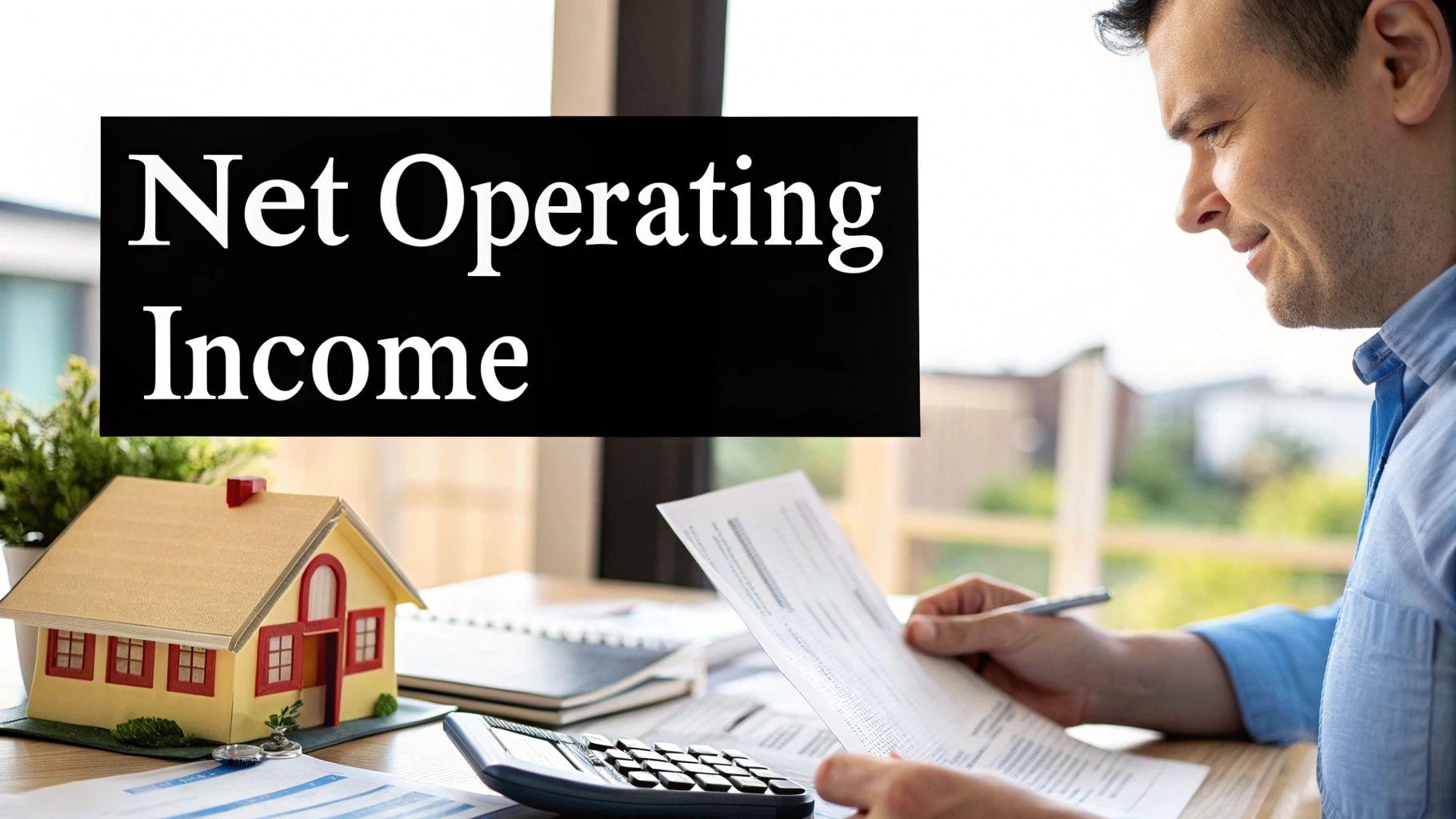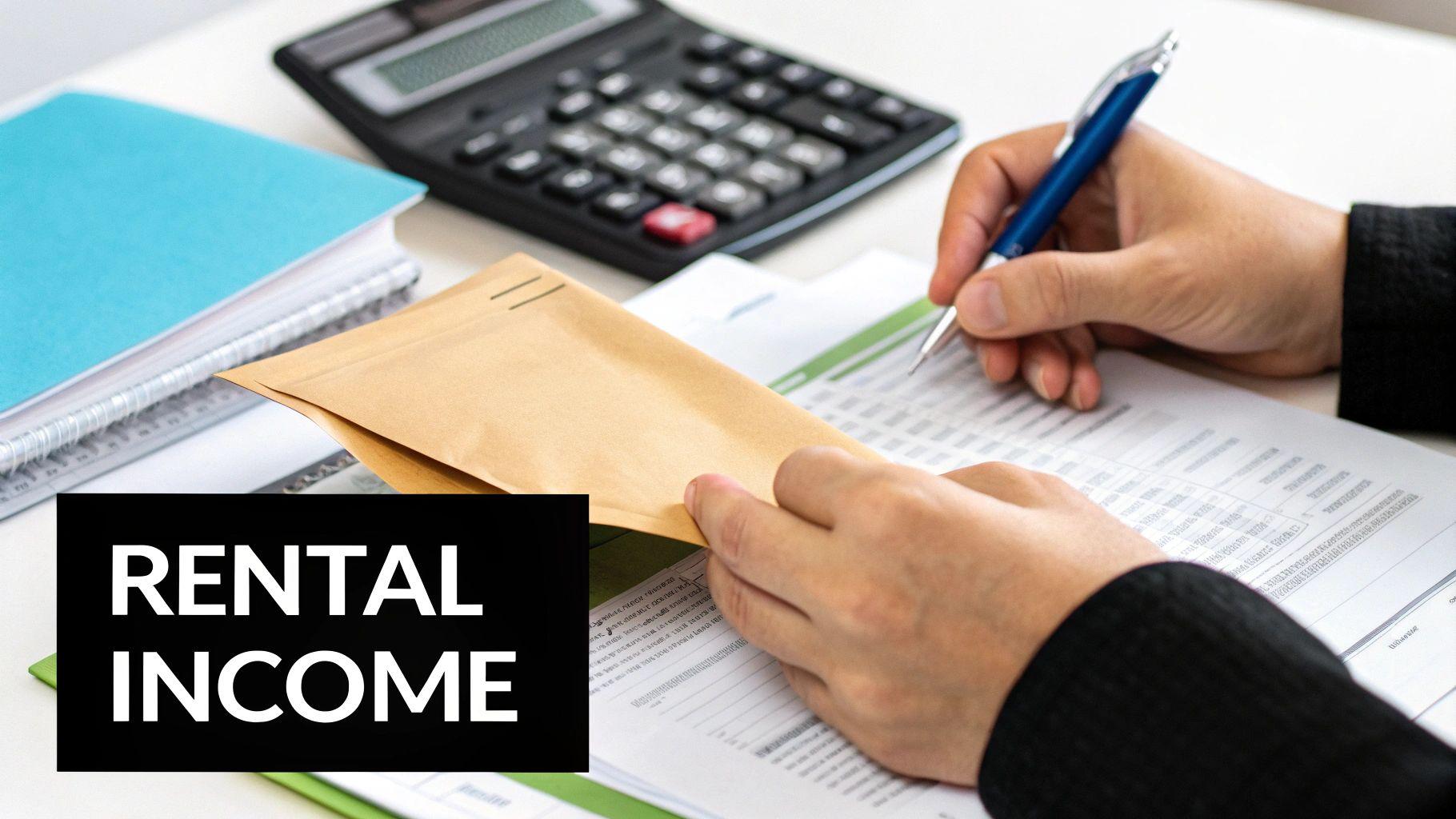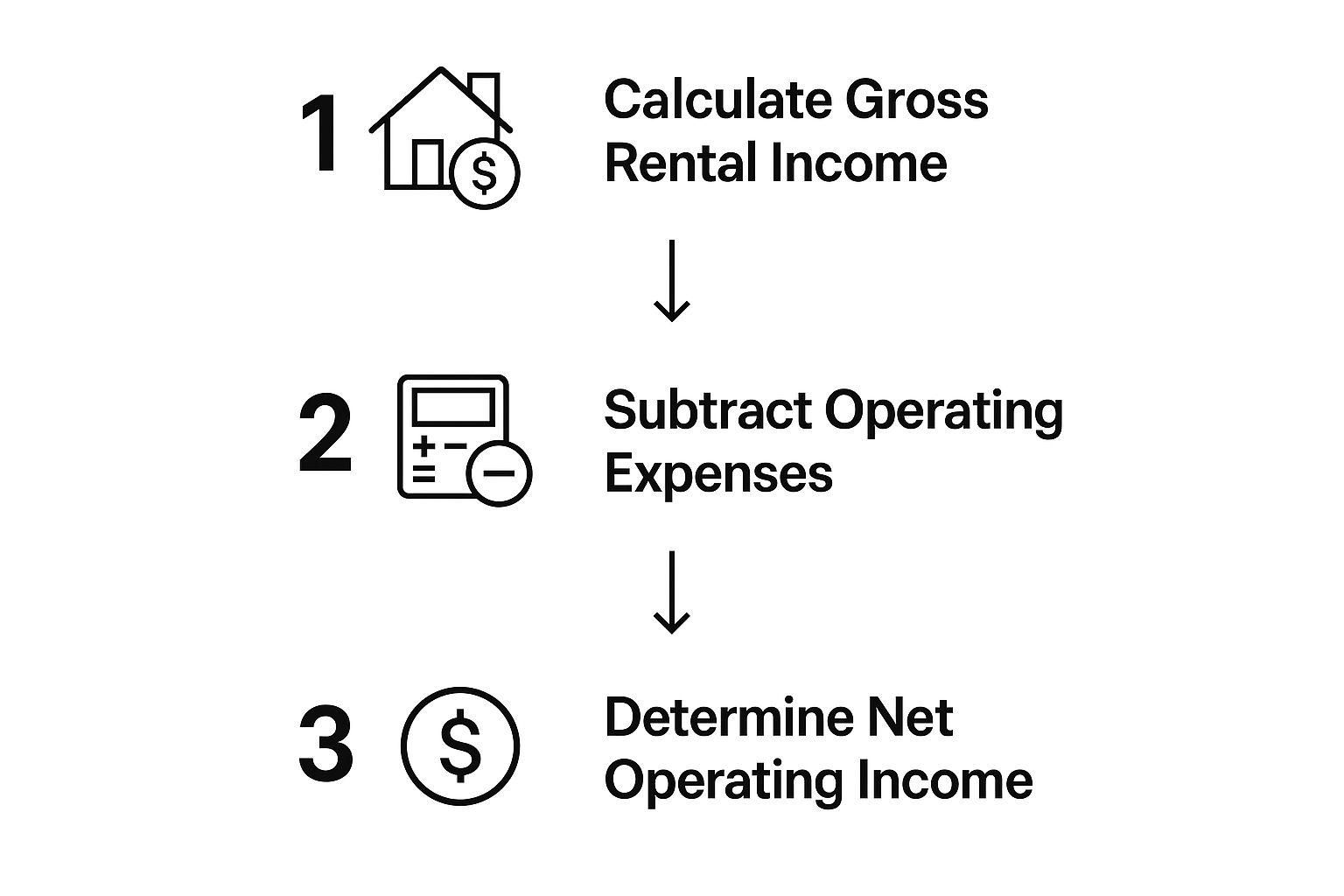How to Find Net Operating Income: Easy Steps to Success
How to Find Net Operating Income: Easy Steps to Success
Learn how to find net operating income with our simple guide. Discover effective methods and boost your financial understanding today!
Domingo Valadez
Jul 16, 2025
Blog
At its core, Net Operating Income (NOI) is a simple calculation: you take all the money a property brings in and subtract everything it costs to run it. The formula itself is straightforward: NOI = Total Income - Operating Expenses. But what that single number tells you is the key to understanding a property's true profitability, before debt or taxes ever enter the picture.
What Net Operating Income Really Tells You

Before we get into the nitty-gritty of the math, let’s talk about why this metric matters so much. Think of NOI as the purest measure of a property's ability to make money. It completely isolates the property's performance from any financing or tax situations specific to the current owner.
This is precisely why seasoned investors, lenders, and especially real estate syndicators lean on it so heavily. It creates a level playing field, giving you a clean, apples-to-apples way to compare one property to another, no matter how the deals are structured.
Building Your Intuition
Let's ground this with something familiar—a local coffee shop. The shop’s income is everything it sells: coffee, pastries, merchandise. Its operating expenses are all the things needed to keep the lights on and the doors open. We're talking about staff wages, the cost of beans and milk, utilities, and marketing.
The shop's Net Operating Income is simply the difference. If it pulls in $27,000 in revenue one month and has $18,000 in operating costs, its NOI is $9,000. For a deeper dive into these kinds of financial calculations, Salesforce.com offers insights on managing the revenue lifecycle.
Applying NOI to Real Estate
This same exact logic applies to real estate. For a multifamily apartment building, the income side isn't just rent. It also includes other revenue streams you might not think of at first, like:
* Parking fees
* Laundry machine collections
* Pet fees
* Vending machine revenue
On the expense side, you have everything it takes to run the property—from property management fees and insurance to routine maintenance and landscaping.
By calculating NOI, you get a clean, unbiased snapshot of the property's financial health and how efficiently it's being managed. It strips away factors unique to the owner, like their mortgage interest or tax bracket. For real estate syndicators, this number is the absolute bedrock of every investment decision, providing the essential data needed to project returns and determine if a deal is even worth pursuing.
Figuring Out What Your Property Really Earns

Before you can get to your property's Net Operating Income, you need to nail down its actual income. This isn't just a fantasy number; it’s about what cash truly hits the bank. The whole process starts by analyzing your property's rental income data to find a realistic baseline.
We begin with a term you'll see everywhere: Potential Gross Income (PGI). Think of this as the absolute best-case scenario—the total rent you'd collect if every single unit was occupied 365 days a year at full market rent. It's a useful starting point, but let's be honest, that perfect world doesn't exist in real estate.
Getting Real About Your Revenue
Now, we have to bring that PGI number back down to earth. Every experienced investor knows you have to account for the hiccups. The two big ones are vacancy—the time a unit sits empty between tenants—and credit loss, which is the unfortunate reality of rent that's owed but never paid.
Subtracting these realities from your PGI gives you a much more honest assessment of your rental revenue. But your work isn't done. A lot of investors miss out by forgetting the "other" income streams that can really boost the bottom line.
- Laundry Machines: That coin-op or card-swipe laundry room is a classic cash-cow.
- Parking Fees: Charging for reserved or covered spots is easy, consistent income.
- Storage Units: Renting out small on-site lockers or garages can be surprisingly lucrative.
- Pet Fees: One-time fees and monthly pet rent can add up quickly across a property.
When you add this ancillary income to your vacancy-adjusted rental income, you arrive at your Effective Gross Income (EGI). This figure is the true top line for your NOI calculation and gives a far more accurate picture of the cash your property can actually generate.
Let's Run the Numbers
Imagine you're looking at a four-unit building. The broker's pro forma might boast a PGI of $72,000 a year. If you conservatively budget for a 10% combined vacancy and credit loss, that number immediately drops to $64,800.
But then you discover the coin-op laundry brings in an extra $1,000 a year. Suddenly, your EGI is $65,800. This is the number that matters. Getting this income figure right is just as critical as when you https://www.homebasecre.com/posts/how-to-calculate-equity-multiple for your partners. It's the first, and most important, half of the NOI equation.
Identifying Every Operating Expense

Now that you’ve got a handle on the income side of your property, it’s time to flip the coin and look at your operating expenses. Honestly, this is where I see most new investors stumble. It's so easy to either miss critical costs or, more often, throw in expenses that have no business being in your NOI calculation.
To get this right, you need to be meticulous. I find it helps to think of expenses in two distinct buckets: fixed and variable. The fixed ones are your predictable, recurring costs. The variable ones... well, they keep things interesting.
Fixed And Variable Operating Expenses
Your fixed expenses are the ones you can almost set your watch to. They show up month after month, year after year, no matter how many units are filled.
- Property Taxes: This is a non-negotiable bill from your local government.
- Insurance: The premium you pay for hazard, liability, and other essential coverages.
- Property Management Fees: Typically a set percentage of the rent collected each month.
Variable expenses are a bit trickier because they can swing with occupancy, the season, or just plain bad luck. These are things like utilities (if tenants aren't paying them directly), ongoing maintenance and repairs, landscaping, pest control, and all the small administrative costs that add up. The best way to forecast these is to dig into the property’s history or look at comparable properties in the area.
The most important lesson here is learning what not to include. True operating expenses are only the costs tied directly to the day-to-day running of the property. This means you have to draw a firm line and leave out your loan payments, income taxes, and any big-ticket capital improvements.
Why the strict focus? Because it isolates the property's performance from the owner's unique financing or tax situation. This gives you a pure look at how well the asset itself is operating, a standard practice you'll see used by savvy investors everywhere. If you want to dive deeper, you can explore more about how financial metrics are applied globally to sharpen your investment strategy.
Common Costs To Exclude
Getting this part wrong can completely derail your analysis. You absolutely have to know which expenses to keep on the sidelines when calculating NOI.
The table below breaks it down clearly. Confusing operating expenses with these other costs is a classic rookie mistake that leads to a skewed and unreliable picture of a property's financial health.
Operating Expenses vs. Non-Operating Expenses
Remember, NOI is all about the property's operational profitability. Keep these non-operating items separate, and you'll have a much clearer, more accurate metric to guide your investment decisions.
Putting It All Together to Analyze Your Deal
Alright, you've done the hard work of gathering your income and expense figures. Now it’s time for the payoff—calculating the Net Operating Income, or NOI. This is the moment of truth where you see if a property truly performs.
The formula itself couldn't be simpler: just subtract your total operating expenses from your effective gross income (EGI). But the result? That single number tells a powerful story about the health of your potential investment.
A Practical Walkthrough
Let's circle back to our four-unit apartment building example. We landed on an EGI of $65,800 after accounting for potential vacancies. On the other side of the ledger, we tallied up all the legitimate operating expenses—property management, taxes, insurance, maintenance, and utilities—which came out to $28,500 for the year.
Here’s how the math shakes out:
$65,800 (EGI) - $28,500 (Operating Expenses) = $37,300 (NOI)
That $37,300 is the magic number. It represents the property's annual profit before you factor in any loan payments or income taxes. Think of it as the pure, unvarnished earning power of the asset itself.
This visual breaks down the flow perfectly, showing how you start with broad income and systematically narrow it down to the core profit figure.

As you can see, getting to the NOI is a logical process of refinement.
From NOI To Deeper Analysis
Now, calculating the NOI is one thing. Knowing what to do with it is where experienced investors separate themselves from the pack. The NOI is the launchpad for several other critical metrics that let you really dig into a deal's potential. A crucial next step is to consider your financing, for which understanding investor loan interest rates is fundamental.
The most immediate and powerful use for NOI is calculating the Capitalization Rate, or "Cap Rate." This metric is the lifeblood of commercial real estate analysis, giving you a standardized way to size up a deal and compare it against other opportunities in the market.
To get your Cap Rate, you simply divide the NOI by the property’s purchase price.
Let's say the asking price for our four-unit building is $500,000. The Cap Rate calculation would be:
$37,300 (NOI) / $500,000 (Purchase Price) = 7.46%
That 7.46% isn't just a number; it’s a benchmark. It tells you the potential annual return on your investment if you paid in all cash, allowing you to quickly judge if the property is priced fairly for the income it generates.
Common NOI Mistakes That Cost Investors Money
Getting your Net Operating Income calculation right is the bedrock of a solid real-world investment. A small miscalculation can snowball, turning what looked like a promising deal into a serious financial headache. The best way to protect your capital is to learn the common traps that can throw this number off.
I’ve seen this happen countless times: an investor gets a pro-forma from a seller and takes it as gospel. Please don't do this. A seller's pro-forma is a sales document, plain and simple. It's designed to show the property in its best possible light, often with unrealistic assumptions like 100% occupancy and suspiciously low expenses. Your first job is to set that document aside and start your own independent verification process, digging into every single line item with real, current market data.
Misclassifying Major Expenses
Another classic blunder is mixing up capital expenditures (CapEx) with operating expenses. This one is subtle but has huge consequences. An operating expense is a day-to-day cost—think paying the utility bills or painting an apartment after a tenant moves out. A CapEx is a major, one-off upgrade that improves the asset, like replacing the entire roof.
If you mistakenly classify a $20,000 roof replacement as a routine operating expense, you’ll absolutely demolish your NOI for that year. It will make a perfectly healthy property look like it's hemorrhaging cash. On the flip side, completely ignoring upcoming CapEx needs paints a dangerously rosy picture of the property's financial health, setting you up for a nasty surprise down the road.
Pro Tip: A smart investor always budgets for a CapEx reserve. While this reserve isn't technically part of the NOI formula itself, it's a non-negotiable part of responsible underwriting. It's your financial cushion for the big-ticket items that will inevitably come up.
Using Outdated Or Incomplete Data
Relying on old information is another surefire way to make a bad call. The real estate world moves fast. Property taxes are reassessed, insurance premiums climb every year, and utility rates can change with the seasons. Using last year's numbers might seem close enough, but it could lead you to underestimate your actual operating costs by thousands of dollars.
Here’s your defense plan against these common mistakes:
- Verify everything. Get fresh quotes for property insurance. Look up the most recent property tax assessments for the area, and don't assume they won't go up after the sale.
- Factor in vacancy. No property is 100% full all the time. Instead of the 0% vacancy rate you'll see on a pro-forma, plug in a realistic number for the local market, which is often between 5-10%.
- Get your boots on the ground. A thorough property inspection will reveal all the deferred maintenance that doesn't show up on a spreadsheet. A leaky faucet or an aging HVAC unit is a future expense waiting to happen.
- Sweat the small stuff. Don't forget to account for costs like landscaping, pest control, bank fees, and even software subscriptions. They add up.
By pressure-testing every single assumption and digging for the genuine numbers, you build an NOI calculation that reflects reality, not a sales pitch. This is the diligence that separates calculated investing from reckless gambling, ultimately protecting your capital and paving the way for a successful deal.
Diving Deeper: Your Top NOI Questions Answered
Even with the formula down, some of the finer points of Net Operating Income can be a bit tricky. Let's tackle the questions I hear most often from investors. Getting these concepts locked in will give you the confidence to use NOI effectively in your own deal analysis.
How Is NOI Different From Net Income?
This one trips people up all the time. The simplest way to think about it is that Net Operating Income (NOI) measures a property's profitability before you factor in the mortgage or income taxes. It’s a pure reflection of how well the property itself is performing as a business.
Net income, however, is what's left in the bank after everything is paid, including those big-ticket items like debt service and taxes. Net income shows you the actual cash flow an owner pockets, while NOI is the gold standard for comparing one property's operational health against another.
The crucial takeaway is that NOI strips out the owner's specific financing and tax situation. This is why it’s the best metric for a true apples-to-apples comparison between different investment opportunities.
How Does NOI Affect a Property's Value?
The link between NOI and a property's value is direct and incredibly powerful. When investors and appraisers want to figure out what a property is worth, they almost always start with its NOI. The most common tool for this is the Capitalization (Cap) Rate formula:
Property Value = Net Operating Income / Cap Rate
As you can see from the formula, if the market cap rate stays the same, any increase in your NOI leads directly to a higher property value. This is the whole game right here. It's why seasoned investors are obsessed with finding ways to boost NOI—it’s one of the most reliable paths to forcing appreciation and building equity.
Can I Use the Seller's NOI for My Analysis?
In a word: no. You should always start your analysis with the seller's provided NOI, but treat it with a healthy dose of skepticism. Never, ever take it at face value.
It's common for sellers to present a "pro forma" NOI that paints a rosy picture, often using overly optimistic assumptions like near-zero vacancy or under-budgeted repair costs. Your job as a savvy investor is to dig into their numbers, verify every line item against reality and market data, and then build your own conservative NOI. Remember, the deal has to work on your numbers, not theirs.
Ready to stop wrestling with spreadsheets and start managing your deals like a pro? Homebase is the all-in-one platform built by syndicators, for syndicators. Streamline your fundraising, investor relations, and deal management so you can focus on what matters most—growing your portfolio. Explore Homebase today!
Share On Linkedin
Share On Twitter
Share On Linkedin
Share On Twitter
DOMINGO VALADEZ is the co-founder at Homebase and a former product strategy manager at Google.
What To Read Next
Raise Capital for Real Estate A Sponsor Playbook
Blog
Learn how to raise capital for real estate with this sponsor playbook. Get actionable steps on deal structuring, investor outreach, and closing.
Sign up for the newsletter
If you want relevant updates from our team at Homebase, sign up! Your email is never shared.
Sign up for the newsletter
If you want relevant updates from our team at Homebase, sign up! Your email is never shared.
© 2025 Homebase. All rights reserved.